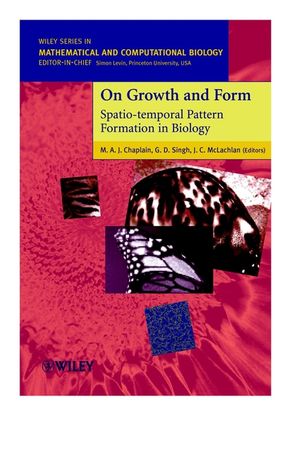On Growth and Form: Spatio-temporal Pattern Formation in BiologyISBN: 978-0-471-98451-1
Hardcover
436 pages
January 2000
 This is a Print-on-Demand title. It will be printed specifically to fill your order. Please allow an additional 10-15 days delivery time. The book is not returnable.
|
||||||
Spatio-temporal pattern formation is a major area of research
within the subject of mathematical biology. The topic involves the
use of mathematical modelling to analyse how patterns in biology
are created and develop. For example, the growth, over time, of the
intricate and beautiful patterns on certain sea-shells or the
striped markings on a tiger can be modelled and their development
predicted in terms of nonlinear mathematical processes. The current
volume captures the breadth of recent research into various aspects
of spatio-temporal pattern and form, such as development biology,
reaction-diffusion systems and morphometrics.
Brings the ideas of the classic On Growth and Form by D'Arcy Thompson, the founding classic of mathematical biology, fully up to date and looks to future developments in the subject.
* Foreword provided by Professor John Tyler Bonner, Princeton University.
* World class collection of internationally renowned contributors from both experimental and theoretical backgrounds
Taking its inspiration from D'Arcy Thompson's classic and still influential volume On Growth and Form, this new volume presents a collection of 21 articles from the Plenary Speakers of the recent D'Arcy Thompson Conference, held at the University of Dundee, 20-24 September 1998. The topics covered include pattern formation in development biology, reaction-diffusion systems, intercellular systems and morphometrics, offering the reader a stimulating blend of theory and experiment.
This book will be of particular interest to bio-mathematicians and development biologists. Paediatric clinicians, evolutionary biologists, orthodontists, anatomists, physiologists and many other members of the biology community will also benefit greatly from it.
Brings the ideas of the classic On Growth and Form by D'Arcy Thompson, the founding classic of mathematical biology, fully up to date and looks to future developments in the subject.
* Foreword provided by Professor John Tyler Bonner, Princeton University.
* World class collection of internationally renowned contributors from both experimental and theoretical backgrounds
Taking its inspiration from D'Arcy Thompson's classic and still influential volume On Growth and Form, this new volume presents a collection of 21 articles from the Plenary Speakers of the recent D'Arcy Thompson Conference, held at the University of Dundee, 20-24 September 1998. The topics covered include pattern formation in development biology, reaction-diffusion systems, intercellular systems and morphometrics, offering the reader a stimulating blend of theory and experiment.
This book will be of particular interest to bio-mathematicians and development biologists. Paediatric clinicians, evolutionary biologists, orthodontists, anatomists, physiologists and many other members of the biology community will also benefit greatly from it.



